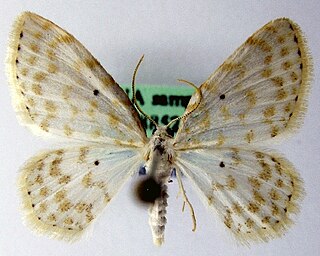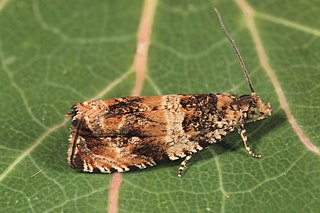
The yellow-breasted racket-tail is a species of parrot in the family Psittaculidae. It is endemic to Indonesia where it is found in Sulawesi's northern peninsula and the Togian Islands in the Gulf of Tomini. Its natural habitat is subtropical or tropical moist lowland forests.

Acronicta auricoma, the scarce dagger, is a moth of the family Noctuidae. It is distributed through most of the Palearctic.

Agapeta hamana is a moth of the family Tortricidae. It is found in Europe, western and southern Siberia, the Caucasus, Kazakhstan, Transcaucasia, Asia Minor, Central Asia, Iran, Afghanistan, Mongolia, western China and northern India.

Arctia villica, the cream-spot tiger, is a moth of the family Erebidae. The species was first described by Carl Linnaeus in his 1758 10th edition of Systema Naturae. It is distributed from the Iberian Peninsula across western and southern Europe, Anatolia, western and northern Iran, western Siberia, southwestern Asia and North Africa.

Setina irrorella, the dew moth, is a moth of the family Erebidae. The species was first described by Carl Linnaeus in his 1758 10th edition of Systema Naturae. It is found in the Palearctic from Ireland, then through Europe and east to northern and central Asia to the Pacific Ocean. It is missing in the high north and parts of the Mediterranean region. It is found also in the limestone Alps up to 2,000 meters above sea level.

Setina is a genus of moths in the family Erebidae.

Setina aurita is a moth of the family Erebidae. It was first described by Eugenius Johann Christoph Esper in 1787.

Scopula rubiginata, the tawny wave, is a moth of the family Geometridae. The species was first described by Johann Siegfried Hufnagel in 1767.

Omphalophana antirrhinii is a moth of the family Noctuidae. It is found from southern France through all southern Europe, Corsica, Sardinia towards northern Iraq, western Iran, Jordan and Israel.

Rhodostrophia calabra is a moth of the family Geometridae first described by Vincenzo Petagna in 1786. It is found from the Iberian Peninsula and a small isolated population in Morocco, through southern France, the western and southern Alps, Italy, the eastern coast of the Adriatic Sea to the southern parts of the Balkan Peninsula. In central Europe it is only found as an isolated population in central France and Rheinland-Pfalz. It is not found on the islands in the Mediterranean Sea. In the Balkans there is an isolated population in the border region of northern Bulgaria and Serbia. Furthermore, it is present on the eastern shores of the Black Sea in Turkey and in the Caucasus.

Hadula odontites is a moth of the family Noctuidae. It is found from the Iberian Peninsula through central and southern Europa, east up to Ukraine. In the south it is found in the Mediterranean Sea area and Asia Minor, northern Iran, southern Russia, up to Mongolia.

Gnophos obfuscata, the Scotch annulet or Scottish annulet, is a moth of the family Geometridae. The species was first described by Michael Denis and Ignaz Schiffermüller in 1775. It is found in northern, central, and southeastern Europe, Scotland, Ireland, and the Iberian Peninsula.

Asthena anseraria is a moth of the family Geometridae. It is known from most of Europe, east to Korea.

Celypha flavipalpana is a species of moth of the family Tortricidae. It is found in most of Europe, except Ireland, Great Britain, Fennoscandia, the Iberian Peninsula and most of the Balkan Peninsula.

Depressaria olerella is a moth of the family Depressariidae. It is found in most of Europe, except Ireland, the Netherlands, the Iberian Peninsula and most of the Balkan Peninsula.

Depressaria artemisiae is a moth of the family Depressariidae. It is found in most of Europe, except Ireland, Great Britain, the Netherlands, Belgium, the Iberian Peninsula and most of the Balkan Peninsula. It is also found in North America.

Setina roscida is a moth of the family Erebidae first described by Michael Denis and Ignaz Schiffermüller in 1775. It is found from western France through central Europe to the Volga area and the Altai.
Holcopogon bubulcellus is a moth of the family Autostichidae. It is found in southern Europe and North Africa.

Chionodes lugubrella is a moth of the family Gelechiidae. The geographical distribution of this species extends throughout Europe, into the Caucasus, Siberia and the Russian Far East. It is also found in North America.

Notocelia tetragonana, the square-spot bell, is a species of moth of the family Tortricidae. It is found in China, Russia and Europe, where it has been recorded from most of the continent, except the Iberian Peninsula, the Netherlands, Denmark and most of the Balkan Peninsula. The habitat consists of woodland and scrubland.

















